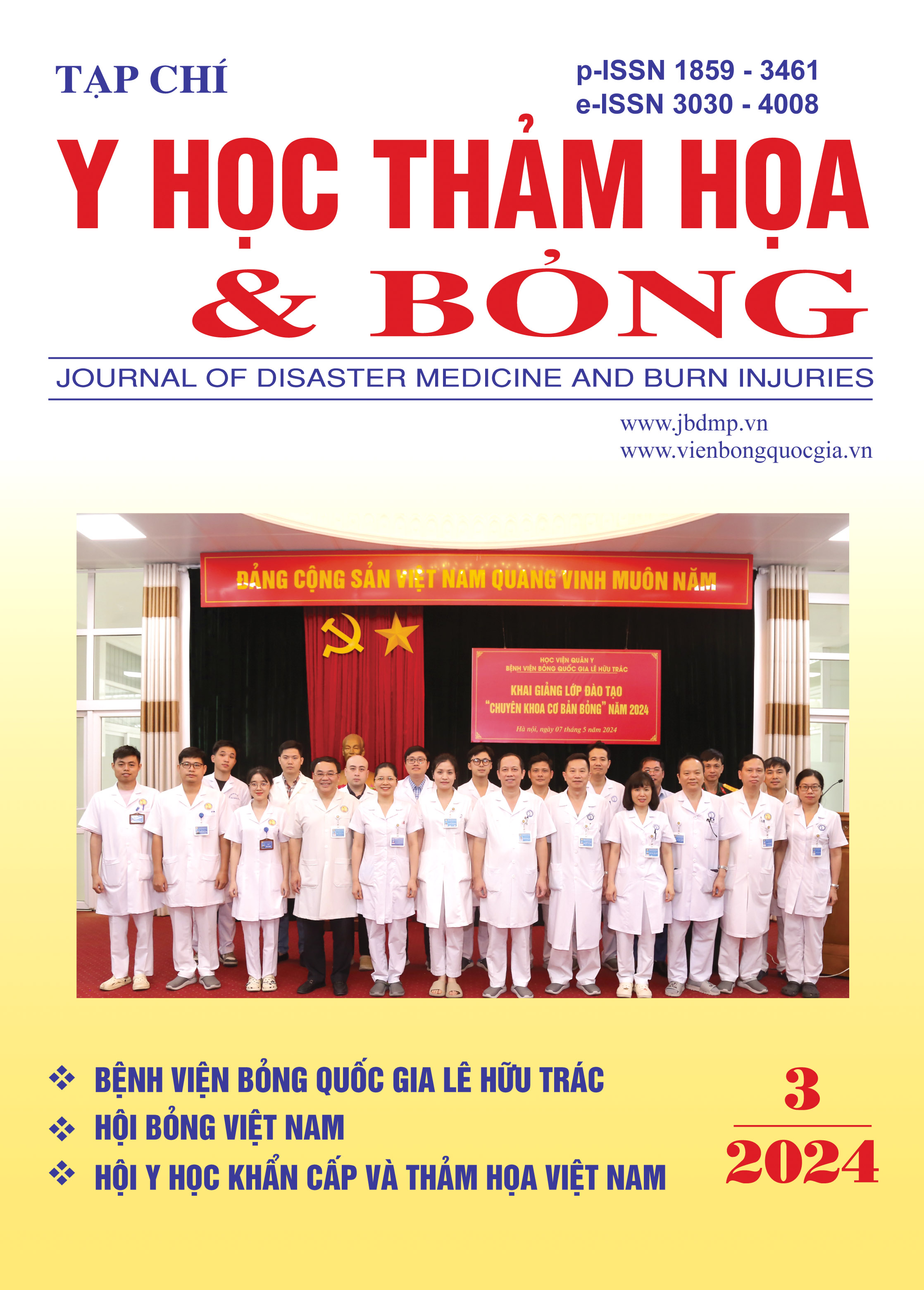Results of applying the free flow-through anterolateral thigh flap for wrist high-voltage electrical burns
Main Article Content
Abstract
Introduction: High-tension electrical burns frequently involve the hand and wrist as these are the most common entry and exit points of the current. High-tension electrical burns in the wrist often cause damage and necrosis of the tendon, nerves, blood vessels, and bones of the wrist, resulting in high disability and amputation rates. For patients with wrist vascular injury with skin and soft tissue defects, a variety of bridge flap blood flow is adopted to not only cover the wound but also restore blood circulation.
Patients and Methods: Five patients with high-tension electrical wrist burns were admitted to Vietnam National Burns Hospital from August 2023 to May 2024. All patients were operated on by using the free flow-through ALT flap to resurface the defect and restore the blood supply of the hand. The vascular injuries were detected by using Doppler ultrasound and angiography. After debridement of the local wound, the ALT flap was harvested on the thigh and anastomosed with recipient vessels.
Results: All 6 patients were male, aged from 22 to 45 years old. The injury sites for all 5 patients were the wrists, specifically 4 right and 2 left wrists. Four patients had radial artery embolism necrosis. Two patients had ulnar arterial embolization and necrosis. Two cases had arterial bleeding at the wrist before surgery. The range of the wound areas after debridement was 10 cm x 9 cm to 26 cm x 16 cm. The flap areas ranged from 13 cm x 12 cm to 29 cm x 17 cm and the length of the bridged blood vessel ranged from 14 cm to 22 cm. The flap after the operation has good characteristics and the circulation of the hand has been restored. The donor site has a hypertrophic scar and the movement of the thigh and knee is not influenced.
Conclusion: Treating wrist high-tension electrical burns in clinical practice is still highly challenging. The use of flow-through anterolateral thigh flaps is a good choice for treating severe wrist electrical burns because of both to recover and to restore the dual blood supply for the hand.
Keywords: High-tension electrical burns, wrist flap surgery, free flow-through anterolateral thigh flaps
Article Details
Keywords
High-tension electrical burns, wrist flap surgery, free flow-through anterolateral thigh flaps
References
2. Lee DH, Desai MJ, Gauger EM. Electrical injuries of the hand and upper extremity. Ame Acad Orthop Sur, 2019; 27, e1-e8.
3. Shen ZY, Chang ZD, Wang NZ. Electrical injury of wrist: classification and treatment--clinical analysis of 90 cases. Burns, 1990; 16, 449-56.
4. Luan A, Galvez MG, Lee GK. Flow-through omental flap to free anterolateral thigh flap for complex chest wall reconstruction: case report and review of the literature. Microsurgery, 2016; 36, 70-6.
5. Qing L, Wu P, Liang J, et al. Use of flow-through anterolateral thigh perforator flaps in reconstruction of complex extremity defects. J Reconstr Microsur, 2015; 31, 571-8.
6. Wang XW, Sun YH, et al. Early vascular grafting to prevent upper extremity necrosis after electrical burns. Chin Med J (Engl). 1981;94:185-194.
7. Cheng, W., Shen, Y. M., Qin, F. J., & Hu, X. H. (2020). Free flow-through anterolateral thigh flaps for wrist high-tension electrical burns: a retrospective case series. Biomedical and Environmental Sciences, 33(7), 510-517.
8. Soutar DS, Scheker LR, Tanner NS, et al. The radial forearm flap: a versatile method for intra-oral reconstruction. British J Plas Surg, 1983; 36, 1-8.
9. Yokota K, Sunagawa T, Suzuki O, et al. Short interposed pedicle of flow-through anterolateral thigh flap for reliable reconstruction of damaged upper extremity. J Reconstr Microsurg, 2011; 27, 109-14.
10. Hsiao YC, Yang JY, Chang CJ, et al. Flow-through anterolateral thigh flap for reconstruction in electrical burns of the severely damaged upper extremity. Burns, 2013; 39, 515-21.
11. Fujioka, M. (2018). Application of free flow-through anterolateral thigh flap for the reconstruction of an extremity soft tissue defect requiring vascularization. Flap Surgery. Rijeka: InTech, 51-76.


